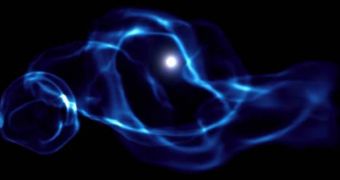According to a new complex computer simulation, it would appear that the earliest black holes that where formed after the Big Bang were in fact a lot smaller than the giants they are today. Also, the simulation revealed that older theories, which held that the formations accumulated mass quickly and gobbled up matter at fast rates, were misplaced and incorrect. The team behind the new study, which appears in an upcoming issue of the Astrophysical Journal Letters, says that the key to understanding black hole formation and evolution is looking at the stars that spawned them.
The scientists, from the Kavli Institute for Particle Astrophysics and Cosmology, a division of the Stanford Linear Accelerator Center (SLAC) National Accelerator Laboratory, in Menlo Park, California, believe that, in the early Universe, the first black holes were formed by exploding stars. But, even before they collapsed upon themselves, these stars burned for several millions of years, removing most amounts of cosmic gas and dust from their immediate vicinity, through either heat, solar winds or massive amounts of radiation.
As soon as the collapse occurred, the newly formed black hole, not that impressive in size, would have immediately begun feeding, except for the fact that there was nothing to feed on. “It has been speculated that these first black holes were seeds and accreted huge amounts of matter. We're just finding out that it could be much more complex than that,” explains KIPACS astrophysicist Marcelo Alvarez, the leader of the new study, quoted by Space.
According to the model's estimates, early black holes only increased in size by less than one percent of their original mass within about a hundred million years, which, even by cosmic standards, is still fairly slow. “It is possible that they merged onto larger objects that then themselves collapsed into black holes, bringing these first black holes along for the ride. Another possibility is that they got kicked out of the galaxy by interactions with other objects and would just be floating around in the halo of the galaxy now,” Alvarez says.
Nevertheless, even in their smaller forms, the black holes would have emitted sufficient high-energy radiations to heat up cosmic gas and dust on a very wide region around them, thus preventing stellar formation, which requires the gas and dust to cool down to a certain point. As the clouds of matter spent millions of years unable to produce stars, the experts believe that at some point they would have collapsed onto themselves, producing the supermassive black holes we see today. However, at this point, this line of thought is only speculation, Alvarez says.
“This work will likely make people rethink how the radiation from these black holes affected the surrounding environment. Black holes are not just dead pieces of matter; they actually affect other parts of the galaxy,” concludes NASA Goddard Space Flight Center expert John Wise.

 14 DAY TRIAL //
14 DAY TRIAL //